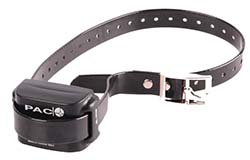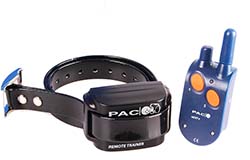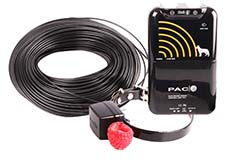
For your first session, make sure that everything is ready to work.
Note if, during an attempted correction, no reaction is observed, you might need to increase the correction level (this should be done gradually). 
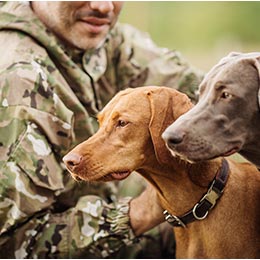

Training StylesThere are two distinct training strategies that are normally used with your PACDOG Remote Trainer. They are .. 
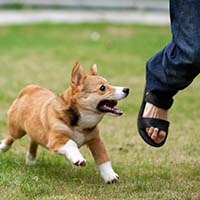
Enforcement of Obedience - Training Style
If for example, you were trying to correct a recall problem, call the dog using your normal voice command or whistle. If the dog does not respond, call them again while pressing the Tone or Vibration pre-warning button, if no response, call the dog again in a manner that suggests your displeasure and working from the minimum correction level on the handset upwards press the correction button initially for about ½ second until the dog reacts, thus enforcing your command. If your dog then comes, praise them, your dog should return to you, encouraged by your praise. If appropriate, you may also wish to use a reward such as a titbit. More often than not, the one correction should cause your dog to obey your command to -come-, to -sit-, to -lie- or whatever. Check that you have achieved your obedience objectives over several more training sessions before gradually reducing the number of times the collar needs to be worn. 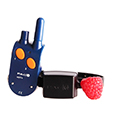
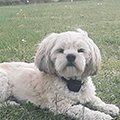
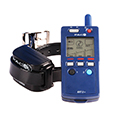
Aversion Therapy - Training Style
Where dogs exhibit anti-social behaviour such as eating their own, or other animals’ faeces, swallowing stones, chasing bikes or cars etc. and often in the case of animal worrying, the technique known as “aversion therapy” is used. For this therapy, it is even more important that the dog has been properly trained to the “dummy effect” so that there is absolutely no association with the equipment. In this strategy, it will be your objective to encourage the perception that there is some sort of magic ring around his quarry. You must appear not to notice what the dog is doing and to appear to take no part in the correction. You give no commands. In this way, the dog will be conditioned to believe that his action alone is the cause of his discomfort. In other words, the dog must believe that the act of picking up faeces or stones, or chasing bikes or cars actually causes the unpleasant sensation. The dog must not be given any indication that you have had anything to do with it, although, having just been corrected, they are very likely to come back to you for comfort. At this stage, of course, you should be prepared to make a fuss and to praise him. This technique is also very successfully applied to dogs that are worrying other animals such as sheep, deer, cattle, cats, chickens etc., where the dog is led to believe that his quarry has teeth in its backside. But, it should not normally be applied in cases of aggression towards humans or other dogs unless specifically advised by a qualified trainer or behaviourist. We would point out at this stage that while your dog might have responded well to the line during conventional, obedience training, when teaching it to leave sheep, for example - his desire level will almost certainly increase dramatically when in full flight. You should therefore be prepared to quickly increase the stimulation level to counterbalance. Just one correction at high level should be sufficient to stop your dog in this adrenaline-assisted rush. After one or two further attempts, the dog should have got the message and sheep should be off the menu, once and for all! Many dogs’ most damning faults that normally require aversion therapy for their long-term cure should only be tackled whilst the dog is in the process of committing the offence. But faults like chasing other animals often only occur quite unexpectedly, when on, for example, a walk in the countryside. This is at a time when perhaps you could be taken by surprise, quite unprepared for the occasion, and possibly miss the opportunity to correct the problem before it is too late. Remember the correct timing of a correction is extremely important. Clearly, it would be far better to avoid this, by planning and setting up the situation in advance, such that you can anticipate your dog’s reaction, without suddenly having to grope for the handset in a panic. The initiative should therefore remain with you when the dog encounters the sheep or deer, since you will know what is going to happen and when it does, you will be prepared to correct the fault at the most appropriate moment. For a dog with a history, for instance, of persistent sheep chasing/worrying, some trainers would prefer to take the dog into a field with sheep and to give it a significant correction whenever the dog turns his head to “eye” to the sheep. Others prefer to let the dog chase and get near to the quarry before administering a correction. Both approaches are extremely effective, but remember - no command is given in these cases. You should appear neither to have taken part in nor even to have noticed the sheep or your dog’s reaction to them. The use of a long flexi-line can be useful here, as a safety back up – just in case something goes wrong – like 1) the PACDOG collar has not been fitted properly and or set correctly 2) the dog is sufficiently aroused to ignore the stimulation or 3) the dog is too well insulated (electrically) - trim his fur a little (see earlier section) 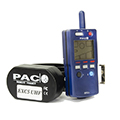
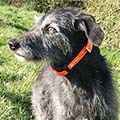
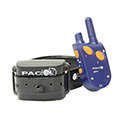
Tone or Vibration Function
See ENFORCEMENT OF OBEDIENCE section
The Tone or Vibration facility on your PACDOG Remote Trainer should be seen quickly to be the preferred solution to long-term
obedience training. It reinforces your voice command or whistle by giving the Tone or Vibration pre-warning when needed. Once
the dog has had the correction a few times the Tone or Vibration pre-warning is usually enough to make it respond to your voice
command or whistle. Training should then progress till the dog begins to defer to your command - without waiting for the tone or vibration
warning. All that remains thereafter is to wean the collar from the dog altogether
Beside the above, super-humane, progressive, training method, the tone or vibration facility can be used effectively
Warnings
You should aim to switch between tone or vibration pre-warning and correction or strong vibration correction on the PAC Buzz collar, in less than one second. This is simple on PACDOG handsets with separate tone buttons. But when operating a handset in multidog Mode, where each dog is controlled from a single trigger, you should practise, without Involving the dog, your ability to alternate accurately between the warning tone or vibration and the correction level for any particular dog. As the training programme progresses, your dog should respond more readily to your commands and your use of correction reduce, thus allowing you to use tone or vibration signals, with little or no need to change to correction. If during training your dog is confronted with another animal (e.g. an aggressive dog or stroppy cow) be careful in the use of the PACDOG collar, whether using tone/vibration or correction, if your dog is distracted during the confrontation, it might just give the other animal (the aggressor) a moment’s advantage, to your dog’s disadvantage. Try to anticipate the situation by getting your dog’s attention - and recalling in good time. We also suggest that initial training be carried out in an area of high visibility in order that you may interact with your dog correctly. It would be wrong to attempt a correction if you cannot see the dog or what it is doing. At the moment you press the trigger button, your dog will form an association with it. If, for example, the dog were on his way back to you at that time, it would create a negative effect in your dog’s mind. Similarly, if you were to correct the dog when in the act of a picking up game it might well associate the correction in a manner that might put the dog off retrieving. Again, we stress, "Timing is of the essence". Some dogs with behavioural problems on-the-line will respond in an altogether different manner off-the-lead; since they know full well whether they are on or off the line (or lead). In this case, the initial training of such dog’s off-the-lead should ideally be carried out in a secure area such as a tennis court, enclosed garden or well-fenced field. From a general animal welfare point of view, it is good practice never to lend the equipment to third parties unless you are confident that they are thoroughly aware of how it works and how it should be used. To this end, please insist that any other prospective user should read this PACDOG Training Guide, followed by the PACDOG Operating Guide before having access to a live training session with the PACDOG remote trainer. Reversion to Old HabitsOnce your dog has been cured, it should be safe off the lead and, provided it has not been presented with blatant temptations, or slack or sloppy instructions on your part, the dog should enjoy an unfettered freedom for the rest of his life. But reversion to old habits (recidivism) can occur, particularly with headstrong or very intelligent dogs. It is your responsibility, as a trainer (and owner) to make sure this does not occur. When you have completed your dog’s obedience training with the PACDOG collar, remember that the dog should, ever after, regard you as top-dog. Be sure, therefore, before giving a command, that the command is necessary. And when you do issue it make sure it is obeyed fully. Otherwise, your dog could start to slip back into his old ways, since it might start to view your stewardship of the ‘top-dog’ position as doubtful. So we repeat – PACDOG Training collars are wonderful aids to training where conventional methods have failed, but they are not intended as a shortcut to conventional training or as an excuse for poor or shoddy training (or control). The PACDOG TeamIn the case of anti-social behaviour, the strength of the instinctive and inherent genes of the dog is often strongly embedded. A fully trained dog, left to his own devices, in some cases, might sooner or later revert to ancestral instincts no matter how well trained, especially if it is continually confronted with unchecked temptation. Guard against this on a continuing basis. If necessary, a regular refresher programme of correction might be required. 
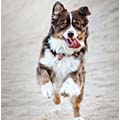


Summary
FinallyBeware of excessive use. A trigger-happy trainer might not only upset his dog with the equivalent of constant ‘nagging’, which would devalue the tool from magic wand to invisible stick. So, if possible, please think twice before giving a correction, treating each time you press any of the triggers - as though you were using a limited supply of golden bullets. Sheep chasing can be cured with just one or two, timely corrections. A headstrong dog that has always to wear the PACDOG collar as an insurance policy in critical areas of the countryside, should almost certainly start to exhibit a high level of obedience, with the occasional, tone or vibration-only reminder - perhaps only a couple of times a month. Always be prepared to seek advice from PACDOG (or your PACDOG agent), qualified trainer or behaviourist. Meanwhile, good luck with your training and please let us know how you get on. We are always delighted to receive testimonial letters or emails from our clients. 
|
 Go to EU Site
Go to EU Site